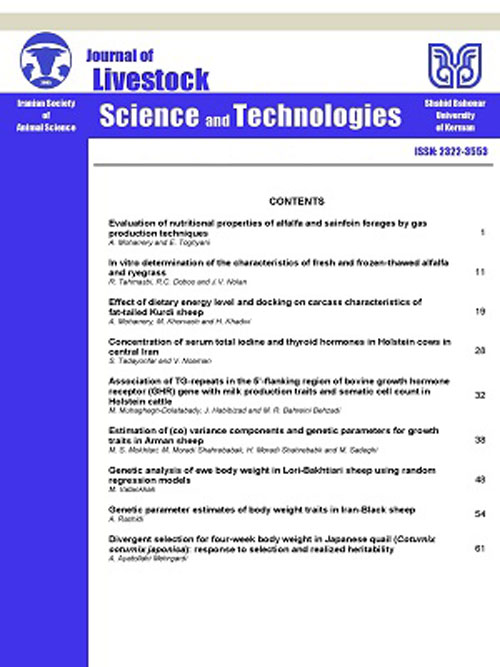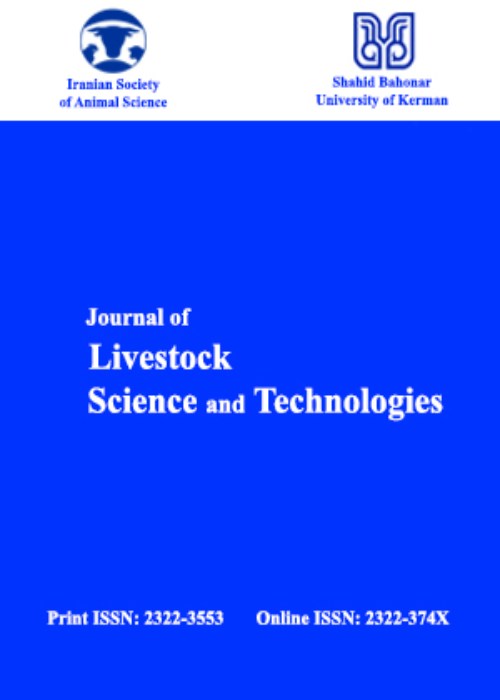فهرست مطالب

Journal of Livestock Science and Technology
Volume:5 Issue: 1, Jun 2017
- تاریخ انتشار: 1396/04/26
- تعداد عناوین: 8
-
-
Pages 1-8An experiment was conducted to study the effects of substitution soybean meal (SBM) with canola meal (CM) and formulated diets based on total and digestible amino acid on performance, egg quality, organs weight and blood parameters of laying hens from 73 to 83 weeks of age. A total of 128 laying hens were distributed by completely randomized design in a 2×2 factorial arrangement with 2 protein sources (soybean meal and 30% soybean replaced by canola meal), and diets were formulated based on two types of amino acid recommendation (total or digestible). Four experimental diets were formulated with four replicates and 8 birds in each. Increased egg weight, egg mass and improved feed conversion ratio (FCR) were shown by soybean than canola meal in the diet (P0.05) by treatments. The results of this study have shown that soybean meal improved performance than canola meal as well as soybean meal diet formulated on digestible amino acid had better effected on performance than total amino acid arrangement in diet.Keywords: canola meal, amino acids, feed formulation, performance, laying hens
-
Pages 9-18There are many studies on the effects of probiotics on performance of broiler chickens, but none of them has evaluated the metabolizable energy (ME) equivalency values of probiotics. The aim of this study was to determine the metabolizable energy equivalency value of Bacillus subtilis spore and its potential for decreasing feed ME content and cost. One hundred seventy-six day-old male broilers (Ross 308) were used in a completely randomized design, with 11 treatments, of four replicates each, and 4 chickens per cage as an experimental unit. Dietary treatments contain a basal diet (2800 kcal/kg) containing graded levels of ME (2850, 2900, 2950, 3000 and 3050 kcal/kg) and Bacillus subtilis (4 × 109 CFU/g DSM 17299) at 0.05, 0.10, 0.15, 0.20 and 0.25 g/kg. Graded levels of feed ME and added Bacillus subtilis were used as independent variables to derive regression equation of performance traits on independent variables. The derived regression equations of body weight and feed conversion ratio (FCR) for ME were set to be equal with those obtained for Bacillus subtilis and were solved; Bacillus subtilis equivalence value for ME was calculated by subtracting the obtained value from ME content of the basal diet. In comparison to the basal diet, added Bacillus subtilis significantly improved the body weight and feed conversion ratio. Metabolizable energy equivalency of Bacillus subtilis for FCR and body weight at 42 days of age was 360366 and 485823 kcal/kg, respectively. Results showed that ME value of Bacillus subtilis was decreased by advancing chickens age.Keywords: Broiler Chickens, Bacillus subtilis, metabolizable energy equivalency
-
Pages 19-24Starch (SS) and fermented fiber (FFS), as energy sources were included in Holstein bull calf diets to evaluate their growth performance, rumen fermentation pattern and concentration of insulin and selected blood metabolites. Fourteen Holstein bull calves (BW=94.5±2.1 kg; age 87±9 d) were allocated to treatments (n=7 calves per treatment) and the study lasted 10 weeks. The diets were based on barley grain and corn silage in SS and FFS treatments, respectively. Dry matter intake was decreased (P 0.05). Fecal score was more watery (= 3.1) in SS compared to FFS (= 2.4) treatment (PKeywords: Holstein bull calves, blood metabolites, energy source, Insulin
-
Pages 25-31This study was carried out in a commercial herd from 2008 to 2012 in order to determine the most prevalent reasons for culling Holstein cows and to assess the effects of risk factors. Overall, 519 (28.2%) cows were culled for involuntary (98.8%) and voluntary 1.2%) reasons. The involun-tary causes of culling were diseases (38.7%), reproduction problems (36.0%), udder disorders (7.7%), lameness (3.7%) and death (12.7%). Mean age of cows at culling was 70.5±15.6 months and the time interval from last calving to culling averaged 263±196 days. Logistic binary regression was used to model the hazard of culling. The analysis of risk factors showed that parity, calving season, and age at first calving had significant effects on the hazard of culling (PKeywords: Holstein dairy cows, culling, udder disorders, Logistic Regression, risk factor
-
Pages 33-41Data from 183 animals raised in 61 flocks were collected to investigate the morpholog-ical characteristics of the Northern Morocco goat. Nine zoometric measures and seven combined indices were obtained. Three zones were defined based on geo-climatic characteristics and environ-mental influences: Mediterranean, Atlantic and Dual. The morphological variables showed the ab-sence of sexual dimorphism in the northern Morocco goat population. Measures were generally very similar (n.s. at pKeywords: Northern Moroccan goat, zoometric measurements, qualitative traits, environmental differentiation
-
Pages 43-50Pedigree information collected from 1979 to 2012 were used to study the genetic varia bility and population structure of Raeini Cashmere goats, taking kids born from 2009 to 2012 into account as the reference population. The mean inbreeding coefficients in the whole and inbred pop-ulations were computed to be 0.04% and 4.41%, respectively. Considering the reference population, the average inbreeding coefficient and average relatedness were 0.14 % and 0.11%, respectively. The mean of generation interval, computed from four gametic pathways (sire-son, sire-daughter, dam-son and dam daughter), was 3.72 years, with a longer interval from dam-progeny pathways relative to sire-progeny ones. In the reference population, the average equivalent complete generation, as a measure of pedigree completeness, was 1.25. The effective population sizes estimated from the indi-vidual rate in coancestry and from the individual increase in inbreeding were 332 and 229, respec-tively. The effective numbers of founders (fe) and the effective numbers of ancestors (fa) were esti-mated at 240 and 137, respectively. Approximately, 50% of the total genetic variations were ex-plained by the first 57 influential ancestors, with a maximum individual contribution of 3.94%. The ratio of fe to fa, as measure of bottleneck, was 1.75. The results revealed the evidences for occurrence of bottlenecks in the population, mainly because of unbalanced contribution of breeding animals to the gene pool of the studied population of Raeini Cashmere goat.Keywords: genealogical parameters, inbreeding, effective population size, goat
-
Pages 51-58In the present study a deterministic bio-economic model was used to estimate economic values for reproduction traits (conception rate, twining rate and litter size), production traits (body weight of kid sold at 6.5 months, annual cashmere weight, body weight of doe and annual milk yield) and longevity (survival of doe, survival of kid until weaning and survival of kid until sale age at 6.5 months), from recording of 10 Rayeni Cashmere goat flocks including 1810 does and 95 bucks in Kerman province in south east of Iran. Sensitivity analysis of economic values to price levels of input and output was also carried out. Revenue sources of production system included: live weight, milk and cashmere production, while live weight was the most important one and included 62.37% of the total revenues. Total profit was 126.2 $ per doe per year. The most important traits were annual milk yield followed by litter size with relative importance of 0.99 and 0.016, respectively. The lowest relative importance was body weight of doe (-0.040). In this system, all the economic values were positive except body weight of doe. Changes in prices of input and output had slightly effects on economic values.Keywords: Rayeni cashmere goat, economic value, pasture system
-
Pages 59-65This study was conducted to estimate the genetic parameters of litter size (LS) in Moghani sheep using threshold model via Bayesian approach. The data originated from the Jafar-Abad Station of Ardabil province, Iran, and included 9698 lactation records of 4977 ewes with lambings from 1995 until 2010. The pedigree file consisted of data on animals born from 1987 to 2010. The significance of fixed effects was examined using the Logistic procedure. Six different animal models were fitted by considering direct genetic effect, including and excluding maternal effect (with and without covariance between maternal and direct genetic effects) as well as permanent environmental effect via Bayesian approach. The genetic parameters were estimated using the THRGIBBS1F90 program. The most appropriate model for LS was determined based on the Deviance Information Criterion (DIC). Based on the obtained results, the second model that included the direct genetic and permanent environmental effects of the ewe was chosen as the best model. Using the second model, the estimates of direct heritability, permanent environmental effect of the ewe and repeatability were 0.041, 0.027 and 0.068, respectively. The low estimates of genetic parameters obtained in the current study for LS in Moghani sheep indicated that selection based on the ewes own performance may result in slow genetic improvement.Keywords: deviance information criterion, genetic parameters, Sheep, threshold model


